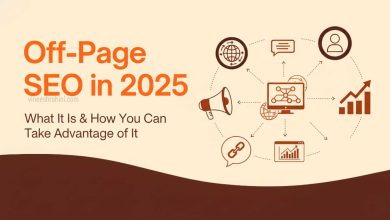Blogging vs Video Content : What Converts More ? : Comprehensive Guide 2025
Blogging vs Video Content : In 2025, content marketing has reached a new level of sophistication. While the internet continues to be flooded with content daily, the real winners are those who adapt to shifting trends, consumer behaviors, and platform algorithms. Blogging and video content remain the two most dominant formats in digital marketing. Blogging is still a powerhouse in SEO, generating long-term organic traffic and leads through keyword-targeted articles.
Table of Contents
Meanwhile, video content is thriving more than ever with the explosive growth of platforms like TikTok, YT Shorts, and Insta Reels, offering unmatched engagement and virality potential. Google’s introduction of Search Generative Experience (SGE) in 2024 now prioritizes multi-format content, making it crucial to understand which format not only drives traffic but also conversions. In this comprehensive guide, we’ll explore which content format—blogging or video—delivers better conversion results in 2025 and how businesses can strategically choose the right one.
Understanding Blogging in 2025
Blogging has evolved far beyond simple articles. Today, it’s a strategic marketing channel focused on long-form, value-rich content. High-ranking blog posts in 2025 often include embedded videos, infographics, FAQs, AI-optimized keyword density, schema markups, and user-focused formatting. Blogs dominate Google’s search results, particularly for informational and transactional queries. Affiliate marketers, SaaS brands, coaches, eCommerce platforms, and digital creators heavily rely on blogging to capture search intent and build authority.
Also Read : Digital Marketing for Startups: Growth Hacks for 2025
Thanks to AI writing tools like Jasper, SurferSEO, and ChatGPT, content creation is faster and more optimized, but also more competitive. Despite the flood of content, unique, experience-based blogging still ranks and converts well when executed strategically.
Understanding Video Content in 2025
Video content is now king on most social platforms. With human attention spans shrinking and mobile consumption increasing, short-form video dominates user engagement. Platforms like YouTube, TikTok, Instagram, and Facebook prioritize videos in their algorithms, rewarding high retention, completion rate, and interaction. Video content in 2025 spans multiple forms: tutorials, reviews, vlogs, reels, live streams, explainers, and AI-generated avatars.
Even B2B marketers are increasingly adopting video for lead generation. Video creates emotional connection, enhances trust, and simplifies complex messages—all essential elements for high conversions. Moreover, tools like Pictory, Synthesia, and Sora by OpenAI enable fast, scalable video production even without appearing on camera.
Traffic Potential: Blogging vs Video Content

When it comes to driving traffic, both blogging and video content shine in different ways. Blogging attracts long-term organic traffic via Google Search. Well-optimized blogs for long-tail keywords can rank for months or even years without additional promotion. Blog posts can appear in featured snippets, “People Also Ask,” and image results, enhancing click-through rate. In contrast, video content, especially short-form, benefits from algorithm-driven discovery.
Platforms push new videos into user feeds, giving even small creators a chance to go viral. Videos on YouTube also rank well on Google, especially for how-to queries and product searches. Video often gets more immediate reach, while blogs win in long-term consistent traffic. In terms of traffic generation, both formats are powerful, but video has a stronger advantage in speed and scale.
Engagement Metrics Comparison
Engagement plays a crucial role in conversion optimization. A user who reads or watches for longer is more likely to convert. Blogging sees good engagement when formatted correctly—think bullet points, internal linking, table of contents, and visuals. The average time on page for a long-form blog is 3–7 minutes. However, most users skim blogs rather than read every word. Videos, on the other hand, demand and capture attention more effectively.
Watching someone explain a concept, unbox a product, or share a story builds trust and emotional resonance. Videos hold viewer attention longer and can deliver your entire message without requiring the user to scroll. In 2025, video content has higher average engagement, especially when optimized with hooks, subtitles, and value-packed scripting.
SEO Impact in 2025
Search engine optimization has been the stronghold of blogs for over two decades, and that remains true today—mostly. Google still heavily relies on textual content to understand topics and serve results. Blogs optimized with headings, metadata, schema, and backlinks remain dominant in search results. However, Google’s SGE has introduced video snippets alongside traditional blog listings, making video SEO more relevant than ever. YouTube is also the second-largest search engine globally. Optimizing videos with keywords in titles, descriptions, tags, and transcripts can dramatically increase discoverability. While blogging holds a stronger position in classic SEO, video is gaining ground quickly and is essential for visual searches and how-to topics.
Conversion Rates: What Converts More in 2025?

Conversion is the ultimate goal. Whether it’s capturing emails, making a sale, or driving app downloads, content needs to convert. Blogging drives conversions by targeting high-intent keywords and offering clear CTAs. For example, review blogs and product comparisons often include affiliate links or form submissions, which convert well. Blogs allow users to make informed decisions through logical arguments. On the other hand, video content builds instant credibility.
Product demo videos or founder stories can convert cold audiences faster because they trigger emotions and human connection. Videos with embedded CTAs or end-screen links can convert viewers directly on platforms like YouTube. Studies in 2025 show that landing pages with a video convert up to 80% better than those without. If the goal is faster decision-making, video wins. If the goal is thoughtful conversions from informed users, blogging has the edge.
Cost, Time, and Resource Investment
Creating high-converting content requires time and money. Blogging is relatively low-cost. A decent 2000-word blog post might take 4–6 hours to create or cost $50–$300 if outsourced. You’ll need hosting, a domain, and maybe some SEO tools. It’s affordable for beginners. Video creation, however, is more resource-intensive. Equipment, editing software, lighting, and scriptwriting all factor in.
Even with AI tools like Pictory and Synthesia, quality videos demand either time or money. Outsourced video content can cost $100–$500 per video depending on complexity. While blogging is better for budget-conscious marketers, video content yields better ROI when scaling with paid ads or brand partnerships.
User Experience and Consumption Habits
User behavior in 2025 is mobile-centric and fast-paced. The younger demographic consumes content via Reels, Shorts, and TikToks. They prefer watching over reading. Video caters to this trend perfectly. It allows passive consumption, which fits well with multitasking audiences. Blogs, though still popular with search users, especially in the 30+ demographic, require active reading.
Some users prefer skimming blogs to quickly find answers. Videos offer more immersive storytelling while blogs provide more control to scan and absorb information at one’s own pace. Depending on your target audience’s age, behavior, and intent, one format may outperform the other.
Monetization Opportunities: Blog vs Video
Both blogging and video content offer robust monetization opportunities. Blogs generate income through affiliate marketing, ad networks (like AdSense or Ezoic), digital product sales, and sponsorships. Blogs can be monetized on autopilot with SEO traffic. Video content also has various monetization channels: YouTube AdSense, affiliate links in descriptions, sponsorships, brand deals, YouTube memberships, and donations through live streams.
Influencers on TikTok and Instagram also earn through platform creator funds and direct brand collaborations. While blogs offer stable and scalable income, video creators may experience faster monetization through audience loyalty and viral reach.
Adaptability Across Platforms
A blog post can be repurposed into social captions, LinkedIn posts, email newsletters, and downloadable PDFs. Similarly, a single video can be broken into reels, stories, quotes, and thumbnails. Video offers greater cross-platform flexibility today, especially with the rise of omnichannel strategies. Marketers can slice a long-form video into 10 pieces of short-form content and distribute across 6–8 channels. Blogs need to be restructured or rewritten to match different platforms. Video is inherently more adaptable in the current ecosystem where visual content dominates.
Algorithm Preferences in 2025
Platform algorithms are leaning more towards video. Instagram, TikTok, Facebook, and YouTube prioritize video in user feeds and discovery pages. Even LinkedIn has ramped up video reach. Google still favors well-structured blogs, especially for in-depth searches, but their algorithm now blends video results into SERPs. Video thumbnails draw more attention and clicks than blog titles. Marketers need to understand that even though blogging is still viable, ignoring video will limit your organic reach across multiple channels.
Which Format Builds More Trust
Trust is the cornerstone of conversions. Blogging builds trust through authority, expertise, and detailed analysis. A well-written, factual blog with references, testimonials, and statistics feels trustworthy. However, video takes trust to a deeper level. Seeing someone speak confidently, demonstrating a product, or sharing real experiences creates emotional credibility. Video content that shows behind-the-scenes footage, customer testimonials, or founder messages converts faster because people connect with faces and voices more than text.
The Best Strategy: Combine Both Formats

Instead of choosing one, smart marketers in 2025 are integrating both formats. The best-performing campaigns use video for emotional connection and blogging for detailed conversion support. For instance, create a YouTube video explaining a product, embed it into a long-form blog review, add affiliate links, and promote it via social media. This approach multiplies touchpoints and increases your chances of converting across audience segments. Google and other platforms reward multi-format content. Combining blogging and video increases dwell time, engagement, and trust—creating a high-converting digital asset.
Final Verdict: Blogging vs Video Content in 2025
So, which converts more—blogging or video content? The answer lies in your target audience, goals, and resources. If you’re looking for long-term traffic with SEO-friendly assets and low startup costs, blogging is your best bet. If your aim is rapid engagement, trust-building, and brand storytelling, video content delivers faster conversions. But in 2025, the most effective strategy is not choosing one over the other—but using both in tandem. Blogging and video are no longer rivals. They are partners in a content ecosystem that demands both depth and dynamism.
Conclusion
In the content-driven marketing world of 2025, it’s not about blogging vs video content—it’s about how you strategically use both to dominate your niche. Blogs provide depth, search visibility, and trust for logical buyers.
Buy Now : Canva Pro Video And Image Editing Software for 1 Rupees/Day
Videos offer emotional impact, virality, and human connection. When combined, they create a conversion engine that speaks to every part of the customer journey. Whether you’re a business owner, digital marketer, or content creator, leveraging both blogs and videos is the smartest way to increase traffic, engagement, and most importantly—conversions.
Keywords : Blogging vs Video Content – Blogging vs Video Content 2025 – Blogging vs Video Content Guide , Blogging vs Video Content list



